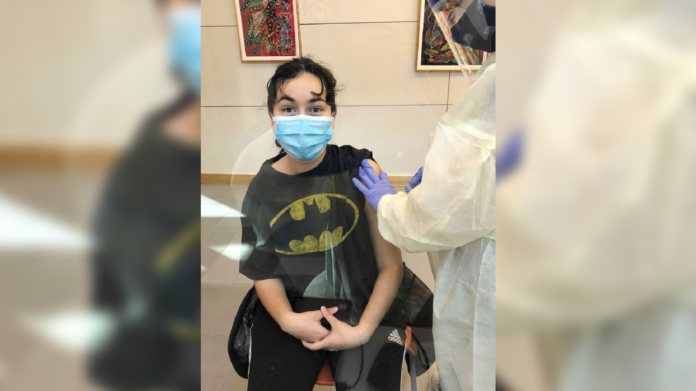A medication that does not come without a side effect doesn’t exist, not leaving out the two COVID-19 vaccines recently approved by the Food and Drug Association for emergency use authorization. Some local residents who have received the first shots of the vaccine to be distributed in the region have reported mild symptoms — all of which expected.
On Tuesday, about 14,600 COVID-19 vaccines reached Rio Grande Valley soil, and healthcare workers and others on the front lines began receiving their first dose of it the following day.
So far, the two companies that have produced the vaccine, Pfizer-BioNTech and Moderna, the latter of which being shipped after receiving approval, require two shots taken about three weeks apart.
Some side effects from either vaccines, according to the Centers for Disease Control and Prevention, include pain and swelling on the arm where injected, and fevers, chills, fatigue and headaches throughout the rest of the body.
The side effects should be taken as “signs that your body is building protection,” according to the CDC.
Sonia Wadekar, a second-year medical student at the University of Texas Rio Grande Valley’s School of Medicine, received her first dose of the COVID-19 vaccine Wednesday on campus.
As of Sunday afternoon, the only side effect she has experienced is soreness around her arm, which she usually gets with shots.
Wadekar, 22, said she understands the apprehension some people may have about receiving the vaccine, since it was developed and approved in just nine months. Vaccines can take years to produce.
“I can totally understand why people are worried to take this; it was a vaccine that was developed so quickly in such a short amount of time,” she said.
After an individual receives the vaccine, it is recommended by the FDA for them to wait 15 minutes under the supervision of healthcare professionals for any serious symptoms that could come up.
During Pfizer’s trials for the vaccine, if someone had experienced adverse symptoms, it happened within half an hour of receiving the shot.
At DHR Health’s vaccinating site, the Edinburg Conference Center at Renaissance, there has been one instance in which medical attention was needed. Last week, after receiving her first dose, a womans’ arm went alarmingly numb. After about an hour or so of assistance, she walked out feeling fine.
Wadekar decided to take the Pfizer vaccine after learning more about how it works, and how it may even be less risky than flu vaccines. Usually, vaccines contain a small amount of the live virus that is trying to be mitigated, such as flu shots.
COVID-19 vaccines work differently; they don’t contain the live virus. The Pfizer and BioNTech vaccine rely on messenger RNA, or mRNA, which carries the genetic coding of the virus, leading the body to build a defense against it. Thus building an immune system strong enough to fend off the virus.
“So when it goes inside your body, your body uses that mRNA as a way to build antibodies (proteins that protect the body) without actually having to fight the virus,” Wadekar said. “It’s new technology that’s really helpful, and you don’t have to worry about your immune system crashing or having to fight harder, compared to taking a vaccine with a live virus.”
Wadekar noted she is glad people are cautious of the treatments they take, and said they should not be concerned with the quality of the COVID-19 vaccine.
“I can totally understand why people would be apprehensive, but I think it’s better to take the vaccine when people do get the opportunity because the new technology is really different compared to what we have had in the past,” she said. “And medical professionals — they are really impressed by this technology and don’t really have worries about it.”
Dr. Wenita Ford, a physician assistant for Dr. Thiendella Diagne’s OB-GYN clinic in Edinburg, received her shot of the COVID-19 vaccine Sunday.
After staying at DHR’s waiting room for 15 minutes, Ford said she only felt soreness, which is common for her when taking any shot.
“It just hurt a little bit, but I expected that from a vaccine,” Ford said.
Like Wadekar, she said she understands why there is apprehension about receiving the vaccine, saying it’s a “personal decision.”
She advises people to read about the vaccines and make the decision for themselves about whether they deem it safe to take. “Read the literature for yourself and gather your own opinion, and make your decision off that,” Ford said.
After doing her own research about the vaccine, she stands by it.
“I do recommend it,” Ford said.
Dr. Amory Baker, a podiatrist at DHR for more than two years, also received his first dose of the vaccine on Sunday. Like Ford, all he had felt within an hour of taking it was some soreness.
He said he was never apprehensive about the vaccine and advises others, when given the chance, to take it also.
“The outcome is going to be better than not getting it,” Baker said. “It’s a small price to pay for that outcome.”
With the development of two vaccines so far, reaching herd immunity, in which a majority of the population has built immunity against the virus, is much more attainable. Wadekar said taking the vaccine is worth risking the side effects for the hope of obtaining herd immunity.
“If we can all join the herd and work together and get the vaccine whenever people get the opportunity, that would be the greatest way to end COVID,” she said.





